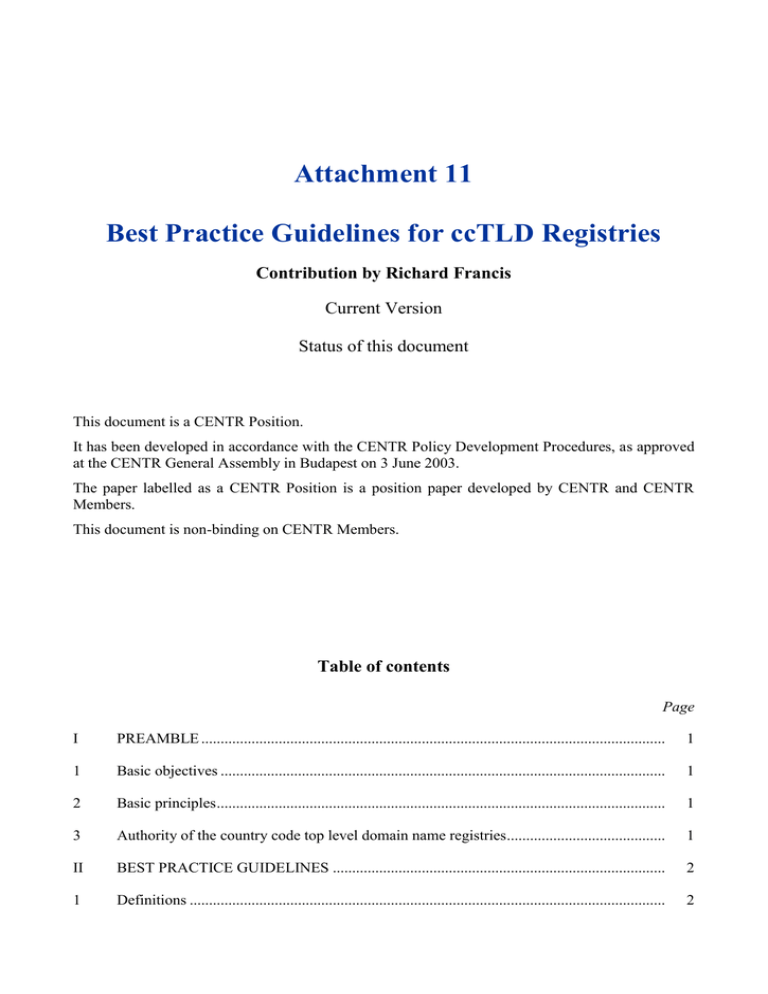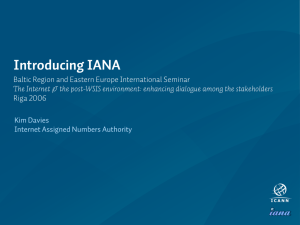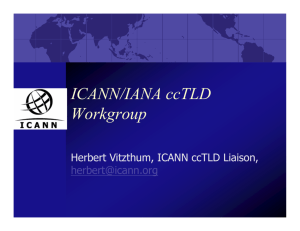Attachment 11 Best Practice Guidelines for ccTLD Registries Contribution by Richard Francis
advertisement

Attachment 11 Best Practice Guidelines for ccTLD Registries Contribution by Richard Francis Current Version Status of this document This document is a CENTR Position. It has been developed in accordance with the CENTR Policy Development Procedures, as approved at the CENTR General Assembly in Budapest on 3 June 2003. The paper labelled as a CENTR Position is a position paper developed by CENTR and CENTR Members. This document is non-binding on CENTR Members. Table of contents Page I PREAMBLE ........................................................................................................................ 1 1 Basic objectives ................................................................................................................... 1 2 Basic principles .................................................................................................................... 1 3 Authority of the country code top level domain name registries ......................................... 1 II BEST PRACTICE GUIDELINES ...................................................................................... 2 1 Definitions ........................................................................................................................... 2 Page 2 Best Practice ........................................................................................................................ 2 2.1 Primary duty of ccTLD Registries ........................................................................ 2 2.2 Consulting the local Internet community .............................................................. 2 2.3 Registration of domain names ............................................................................... 2 2.4 Policies .................................................................................................................. 2 2.5 Location ................................................................................................................. 3 2.6 Technical requirements ......................................................................................... 3 2.7 Changes to information in the IANA database ...................................................... 3 2.8 Financial basis of ccTLD registry operations ........................................................ 3 2.9 Subcontracting of operations ................................................................................. 3 2.10 Data security .......................................................................................................... 3 2.11 Domain name dispute policy ................................................................................. 3 3 Governing law and jurisdiction ........................................................................................... 3 4 Intellectual property rights ................................................................................................... 4 Internet Protocol (IP) – Attachments Best Practice Guidelines for ccTLD Registries As at 19 September 2003 "CENTR Position" I PREAMBLE 1 Basic objectives This Best Practice document is intended to provide guidelines on the operation of country code top level domain name (ccTLD) registries and policies for such registries. It is intended to be a model for ccTLD registries. Whilst recognizing that managers of ccTLD registries do not necessarily fully conform, most of the ccTLD registry community subscribes to the essence of the guidelines set out in this document. 2 Basic principles The Best Practice document closely follows established Internet principles such as: a) self-regulation; b) bottom-up authority (the Internet consists of cooperative networks); c) consensus (requirement for self-regulation); d) transparency (requirement for self-regulation); e) cooperation based on trust and fairness. Any interpretation of the Best Practice document must be consistent with principles a) to e) above. 3 Authority of the country code top level domain name registries Historically, the identity of the ccTLD registry was recorded in the TLD database by the Internet Assigned Numbers Authority (IANA). In March 1994 the management of ccTLD registries was codified, under the guidelines published in RFC 1591 by IANA. A ccTLD registry's authority derives from the local Internet community, as defined in clause II.1. of the Best Practice Guidelines below and from the acceptance of that authority by its local Internet community. That local Internet community has a responsibility to support and protect the ccTLD registry, and to assist the ccTLD registry to serve that community. The function of IANA is recognized and supported by ccTLD registries. It is, however, felt necessary to stress the fact that the local Internet community and the law in the local jurisdiction takes precedence over any recommendations issued by IANA or other bodies. Attachment 11 – Best Practice Guidelines for ccTLDs 1 Internet Protocol (IP) – Attachments II BEST PRACTICE GUIDELINES 1 Definitions ccTLD – a country code top level domain in the global domain name system, using the two-letter code elements from the ISO 3166 standard. ccTLD Registry – an entity that is responsible for administering and operating a ccTLD. DNS – the Domain Name System (see RFCs 1034, 1035 and 2181). Registrant – a company, organization or individual for whom a domain name under the ccTLD has been registered with the ccTLD registry. Registry data – data held in the register database maintained by the ccTLD registry. IANA – Internet Assigned Numbers Authority. Local Internet community - the Internet industry, Internet users, governmental and other public authorities of the country or territory with which the ccTLD is associated. The definition of the local Internet community may vary from one country/territory to another, and is essentially a matter for the community in the country/territory. RFC – the Requests for Comments (RFC) document series is a set of technical and organizational notes about the Internet (originally the ARPANET), beginning in 1969, published at www.ietf.org/iesg/1rfc_index.txt 2 Best Practice 2.1 Primary duty of ccTLD Registries The primary duty of the ccTLD registry is to perform its function in the best interest of, and in consultation with, the local Internet community. 2.2 Consulting the local Internet community For the purpose of consultation, the ccTLD registry should delineate the local Internet community. This process, as well as subsequent consultations, should be transparent. 2.3 Registration of domain names ccTLD registries should: follow policies, rules and procedures that have been established and published, in a transparent manner; register domain names, in an efficient and timely manner; have a standard contract with registrants; provide a public WHOIS service. 2.4 Policies Policies and procedures may vary from country to country owing to, for example, local customs, cultural values, local policies and objectives, law and regulations. However, registration policies should: 2 oblige the ccTLD registry to be equitable and fair to all eligible registrants that request domain names; Attachment 1 – Contribution by Mauritius Internet Protocol (IP) – Attachments define which parties are eligible to register domain names under the ccTLD; require registrants to provide correct data and keep such data duly updated; base the registration on objective criteria which are transparent and non-discriminatory; be documented and publicly available. 2.5 Location The ccTLD registry should be resident or established in the country/territory that the ccTLD relates to, specified in the ISO 3166 standard, unless otherwise accepted or agreed as being in the interest of the local Internet community. 2.6 Technical requirements The ccTLD registry organizes the process of registration and maintenance of domain names, the operation of the domain name servers and the maintenance of the appropriate zone files for the ccTLD. There must be permanent (24 hours, 7 days) Internet protocol (IP) connectivity to an appropriate number of name servers (what constitutes an appropriate number is related to many different factors) and the registry servers. The ccTLD registry's contact details must be published and should be permanently accessible. Duties such as the registration of domain names and operation of name servers must be done with technical competence (see RFC 2181). This includes operating with accuracy, robustness and resilience (see RFC 1591). 2.7 Changes to information in the IANA database The ccTLD registry should inform IANA, in a timely manner, of changes to the information that is maintained in IANA's ccTLD database. 2.8 Financial basis of ccTLD registry operations ccTLD registries should operate on a cost-effective, cost-recovery basis, unless otherwise accepted or agreed by the local Internet community. 2.9 Subcontracting of operations If the ccTLD registry contracts out any or all of the operation and administration of the registry, then it should oblige its subcontractor to follow the requirements of this document. 2.10 Data security ccTLD registries should take reasonable professional measures to ensure that all registry data is secured against damage or loss. 2.11 Domain name dispute policy ccTLD registries should define and publish their domain name dispute policies and procedures. 3 Governing law and jurisdiction The governing law of contracts between the ccTLD registry and registrants and/or registrars should normally be a system of law which obtains within the country or territory to which the ISO 3166 two-letter code relates; or - with the acceptance or agreement of the local Internet community concerned – an appropriate choice of law and jurisdiction from systems of law and jurisdiction commonly used in international commercial contracts. Attachment 11 – Best Practice Guidelines for ccTLDs 3 Internet Protocol (IP) – Attachments 4 Intellectual property rights ccTLD registries may have rights to the intellectu al and other property developed by them as a byproduct of managing the ccTLD registry. The ccTLD registry should take reasonable steps to safeguard any such rights. 4 Attachment 1 – Contribution by Mauritius





